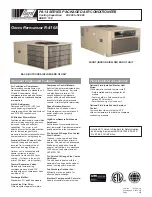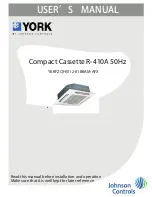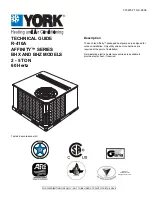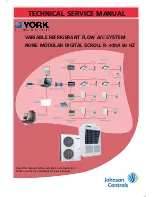
11
GB
D
F
I
NL
E
P
GR
RU
TR
Unit
Range
Setting Method
IC (Main)
01 to 50
Use the most recent address within the same group of indoor units
IC (Sub)
01 to 50
Use an address, other than that of the IC (Main) from among the units within the same group of indoor units. This must be
in sequence with the IC (Main)
Outdoor Unit
51 to 100
Use the most recent address of all the indoor units plus 50
M-NET R/C (Main)
101 to 150
Set at an IC (Main) address within the same group plus 100
M-NET R/C (Sub)
151 to 200
Set at an IC (Main) address within the same group plus 150
MA R/C
–
Unnecessary address setting (Necessary main/sub setting)
h. The group setting operations among the multiple indoor units is done by the remote controller (RC) after the electrical power has been turned on.
<Permissible Lengths>
1
M-NET Remote controller
•
Max length via outdoor units: L
1
+L
2
+L
3
+L
4
and L
1
+L
2
+L
3
+L
5
and L
1
+L
2
+L
6
+L
7
=
500 m (1.25 mm
2
or more)
•
Max transmission cable length: L
1
and L
3
+L
4
and L
3
+L
5
and L
6
and L
2
+L
6
and L
7
=
200 m (1.25 mm
2
or more)
•
Remote controller cable length:
r
1
,
r
2
,
r
3
,
r
4
=
10 m (0.3 to 1.25 mm
2
)
If the length exceeds 10 m, use a 1.25 mm
2
shielded wire. The length of this section (L
8
) should be included in the calculation of the
maximum length and overall length.
2
MA Remote controller
•
Max length via outdoor unit (M-NET cable): L
1
+L
2
+L
3
+L
4
and L
1
+L
2
+L
6
+L
7
=
500 m (1.25 mm
2
or more)
•
Max transmission cable length (M-NET cable): L
1
and L
3
+L
4
and L
6
and L
2
+L
6
and L
7
=
200 m (1.25 mm
2
or more)
•
Remote controller cable length:
c
1
+
c
2
and
c
1
+
c
2
+
c
3
+
c
4
=
200 m (0.3 to 1.25 mm
2
)
9.4. Wiring of main power supply and equipment capacity
Schematic Drawing of Wiring (Example)
[Fig. 9.4.1]
(P.4)
A
Switch (Breakers for Wiring and Current Leakage)
B
Breakers for Current Leakage
C
Outdoor Unit
D
Pull Box
E
Indoor Unit
Thickness of Wire for Main Power Supply and On/Off Capacities
30 A 100 mA 0.1sec. or less
30 A 100 mA 0.1sec. or less
40 A 100 mA 0.1sec. or less
20 A 30 mA 0.1sec. or less
30 A
30 A
40 A
20 A
25
32
40
16
25
32
40
16
4.0
4.0
6.0
1.5
4.0
4.0
6.0
1.5
Indoor Unit
Main Cable
Switch (A)
Minimum Wire Thickness (mm
2
)
Branch
Capacity
Fuse
Breaker for Current Leakage
Model
Outdoor
Unit
200
250
315
1. Use a separate power supply for the outdoor unit and indoor unit.
2. Bear in mind ambient conditions (ambient temperature,direct sunlight, rain water,etc.) when proceeding with the wiring and connections.
3. The wire size is the minimum value for metal conduit wiring. The power cord size should be 1 rank thicker consideration of voltage drops.
Make sure the power-supply voltage does not drop more than 10 %.
4. Specific wiring requirements should adhere to the wiring regulations of the region.
5. Power supply cords of parts of appliances for outdoor use shall not be lighter than polychloroprene sheathed flexible cord (design 245 IEC57). For example,
use wiring such as YZW.
6. A switch with at least 3 mm contact separation in each pole shall be provided by the Air conditioner installation.
Warning:
•
Be sure to use specified wires to connect so that no external force is imparted to terminal connections. If connections are not fixed firmly, it may cause
heating or fire.
•
Be sure to use the appropriate type of overcurrent protection switch. Note that generated overcurrent may include some amount of direct current.
Caution:
•
Some installation site may require attachment of an earth leakage breaker. If no earth leakage breaker is installed, it may cause an electric shock.
•
Do not use anything other than breaker and fuse with correct capacity. Using fuse and wire or copper wire with too large capacity may cause a malfunction
of unit or fire.
<Wiring Method and Address Settings>
a. Always use shielded wire when making connections between the outdoor unit (OC) and the indoor unit (IC), as well for all OC-OC, and IC-IC wiring intervals.
b. Use feed wiring to connect terminals M1 and M2 and the ground terminal on the transmission cable terminal block (TB3) of each outdoor unit (OC) to terminals M1, M2
and terminal S on the transmission cable block of the indoor unit (IC).
c.
Connect terminals 1 (M1) and 2 (M2) on the transmission cable terminal block of the indoor unit (IC) that has the most recent address within the same group to the
terminal block on the remote controller (RC).
d. Connect together terminals M1, M2 and terminal S on the terminal block for central control (TB7) for the outdoor unit (OC).
e. On one outdoor unit only, change the jumper connector on the control panel from CN41 to CN40.
f.
Connect the terminal S on the terminal block for central control (TB7) for the outdoor unit (OC) for the unit into which the jumper connector was inserted into CN40 in Step
above to the ground terminal
in the electrical component box.
g. Set the address setting switch as follows.
*
To set the outdoor unit address to 100, the outdoor address setting switch must be set to 50.
–
–
–
1.5
Breaker for
Wiring (NFB)
Ground
WT03957X01_en
03.3.26, 3:51 PM
11












































